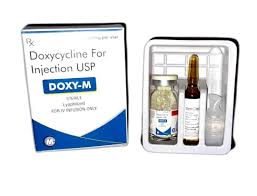Doxycycline:Lupin has received approval from the US FDA to market its Doxycycline for injection-2024
Doxycycline for injection Global pharmaceutical company Lupin Limited (Lupin) announced that it has received approval from the United States Food and Drug Administration (FDA) for its Abbreviated New Drug Application for doxycycline for injection USP, 100 mg/vial (single-dose vial), allowing it to market a generic version of Pfizer Inc.’s Vibramycin for injection, 100 mg/vial. This product will be manufactured at Lupin’s facility in Nagpur, India.
Doxycycline for injection USP is designed to help reduce the development of drug-resistant bacteria and to maintain the efficacy of doxycycline and other antibacterial medications. It should only be used for treating or preventing infections that are confirmed or strongly suspected to be caused by bacteria.
The reference listed drug (RLD) Vibramycin had annual sales of approximately USD 47 million in the US as of January 2024, according to IQVIA.
Lupin is a transnational pharmaceutical company based in Mumbai, India. It focuses on innovation and develops and markets a wide range of branded and generic formulations, biotechnology products, and APIs. Lupin operates in over 100 markets, including the US, India, South Africa, the Asia Pacific (APAC) region, Latin America (LATAM), Europe, and the Middle East.
Doxycycline-Doxycycline for injection
Doxycycline is a broad-spectrum antibiotic that inhibits bacterial growth. It is synthetically derived from oxytetracycline, a tetracycline antibiotic produced by Streptomyces species bacteria. This drug belongs to the tetracycline class of antibiotics (Kundu et al., 2015; Thillainayagam and Ramaiah, 2016). In the early 1960s, Pfizer Inc. developed doxycycline and marketed it under the brand name Vibramycin® (Tan et al., 2011). The Food and Drug Administration (FDA) has approved doxycycline for the prevention or treatment of various conditions, including rickettsial infections, sexually transmitted infections, respiratory tract infections, bacterial infections, Lyme disease, eye infections, anthrax, acute intestinal amebiasis, traveler’s diarrhea, and severe acne (FDA, 2018a). Additionally, doxycycline has been studied as a potential treatment for certain cancers, as research indicates it may inhibit cell growth and invasion, induce apoptosis, and block the cell cycle’s gap phase (Kundu et al., 2015). CDSCO.


The primary focus of this chapter is on the use of doxycycline for malaria prophylaxis, although it has a wide range of other medical applications. In 1992, Pfizer Inc. submitted a new drug application to the FDA, including an indication for malaria prophylaxis in the product insert. This indication was officially added in 1994. The approved dosing regimen for adults involves taking 100 mg per day for 1–2 days before entering an endemic area, continuing the same dosage while in the area, and then taking 100 mg daily for 28 days after leaving. According to the FDA package insert, this regimen is approved for up to 4 months.
Research on the long-term (≥4 months) use of doxycycline for malaria prophylaxis has yielded varied findings regarding its tolerability. Studies on Australian military personnel deployed to Cambodia (n = 600) for 12 months or Somalia (n = 900) for 4 months showed good tolerance, with only a small percentage discontinuing the drug due to adverse events like gastrointestinal symptoms or photosensitivity. However, a survey of 228 U.S. Peace Corps volunteers, who took doxycycline for an average of 19 months, revealed that a significant portion had to change medications due to severe adverse events such as gastrointestinal issues, skin reactions, photosensitivity, and vaginal yeast infections.
In general, research findings indicate that adherence rates for doxycycline in malaria prophylaxis range from 70% to 84%, with adhering to the dosing regimen often proving more challenging compared to weekly prophylaxis medications such as mefloquine and tafenoquine. For instance, a study on U.S. troops in Somalia revealed a 98% adherence rate for mefloquine but only 81% for doxycycline (Sánchez et al., 1993), while another study reported 70% adherence for weekly prophylaxis but only 50% for daily doxycycline (Watanasook et al., 1989). Moreover, adherence to the doxycycline regimen tends to decline over time, as evidenced by a study of Australian soldiers in Cambodia where adherence decreased from 60% at 2 months to 44% at 4 months (Shanks et al., 1995a). Additionally, drugs with longer post-travel requirements, like doxycycline, often exhibit poorer adherence compared to those with shorter post-travel regimens such as atovaquone/proguanil (A/P) (Overbosch et al., 2001).
Other studies have shown higher adherence rates among individuals prescribed once-daily prophylaxis compared to once-weekly prophylaxis. For example, Brisson and Brisson (2012) found that 61% of individuals on once-daily prophylaxis reported complete adherence, while only 38% of those on once-weekly prophylaxis (e.g., mefloquine) did so. Although resistance of P. falciparum to doxycycline is not well-documented, breakthroughs in prophylaxis have been associated with inadequate doses, possibly insufficient serum levels, and poor adherence (Tan et al., 2011).
Before FDA approval for doxycycline use in malaria prophylaxis, the U.S. Army conducted various clinical trials demonstrating its efficacy. A Department of Defense (DoD) memorandum in 2009 recommended doxycycline over mefloquine for service members with neurobehavioral disorders, and current DoD policy favors doxycycline as a first-line prophylactic agent. The military adopted doxycycline for malaria prophylaxis following the anthrax attacks of September 2001, owing to its dual protection against anthrax and malaria threats.
Doxycycline also reduces the incidence and severity of traveler’s diarrhea, providing protection to 60–85% of individuals depending on E. coli resistance. A study comparing diarrhea rates among military teams in Iraq during the Gulf War found that those using doxycycline for malaria prophylaxis experienced lower rates and milder episodes of diarrhea compared to those who did not.
This chapter outlines changes in the doxycycline package insert since its approval for malaria prophylaxis in 1994, focusing on Contraindications, Warnings, and Precautions. It further discusses doxycycline’s pharmacokinetic properties, known adverse events, epidemiologic studies, and supplemental evidence, including case reports and studies on specific groups like pregnant women. The synthesis of evidence concludes the chapter, along with inferences drawn from the presented data.

